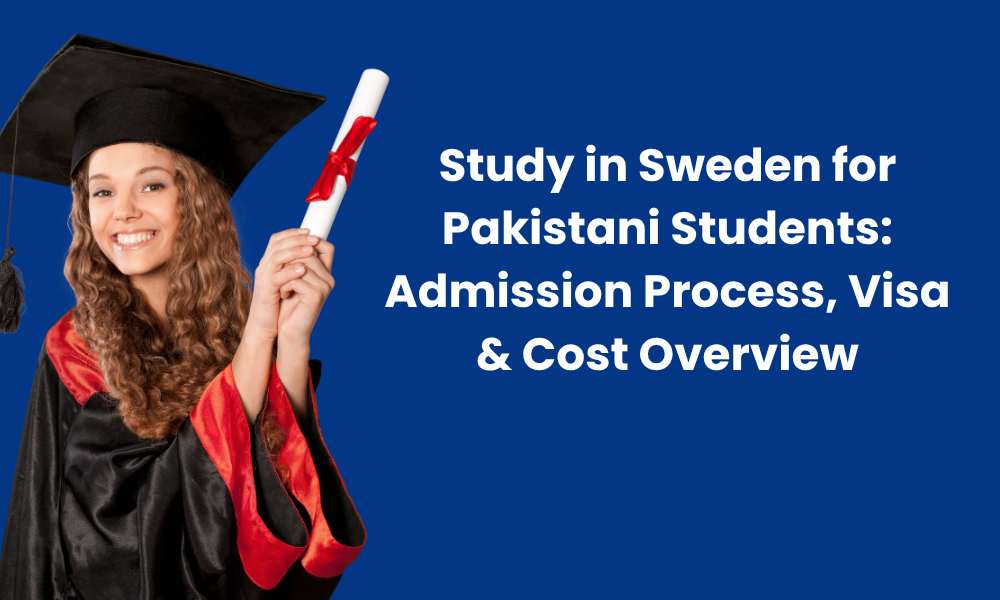Sweden has become one of Europe’s best kept secrets for Pakistani students wanting quality education abroad. There are 39 universities offering English taught programs and scholarships that actually help with costs.
This European country mixes old traditions with new ideas, keeps fees reasonable, and offers stunning views. Pakistani students planning their academic future should definitely look at what Sweden brings to the table.
Why Sweden Stands Out for Pakistani Academics
Sweden offers more than just degrees from European universities. The whole system works well for international students from the ground up. About half the students who apply get accepted, which beats most other European countries. What really catches attention is how classes focus on working together instead of just memorizing facts.
Teachers and students interact differently here compared to back home. Professors go by first names, and asking questions feels natural rather than intimidating. Students develop sharp thinking skills that help long after graduation day arrives. Classrooms bring together people from 150 plus countries, creating connections that last for years.
Global networks become real instead of just something people talk about. Some students also look into options to Study in UK or Study in USA. Sweden still wins when comparing quality education with what it costs.
Understanding the Admission Process for Swedish Universities
Getting into Swedish universities takes planning ahead, not rushing applications at deadlines. The website universityadmissions.se handles most program applications and charges SEK (Swedish Currency, Krona) 900 for international students. Autumn intake opens around mid-October and runs until mid-January. Documents usually need submission by early February.
Bachelor’s programs require Intermediate or HSSC certificates showing 12 years of completed education. Math becomes required for anyone who passed after 2009, especially targeting science or engineering. Master’s applicants must hold a 4-year bachelor’s from an HEC recognized university. No fixed cutoff exists, but staying above 2.5 CGPA or 60% helps a lot.
Proving English skills matters too. IELTS scores should hit 6.0 band minimum, though TOEFL works at some places. Students with O Levels and A Levels sometimes skip English tests altogether. Each university sets its own rules on this.
Applications need transcripts showing previous grades and a Statement of Purpose explaining future plans. Letters from professors or bosses help, plus a passport copy that’s still valid. Art, design, or architecture programs often want portfolios showing past projects. Starting early works better because universities notice the difference between careful and hasty applications.
Students checking other countries can compare requirements for Study in Australia or Study in Ireland. Each place has slightly different standards.
Navigating the Visa Application Journey
After getting accepted, the visa part starts next. Sweden calls it a residence permit for studies officially. Stays longer than 90 days need this permit before flying out. The process stays straightforward if everything gets organized properly and timing works out.
Visa applications cost SEK 1,500, plus proving access to SEK 10,314 monthly for living costs. This money requirement stops students from struggling financially while attending classes. Health insurance covering the whole study period becomes mandatory too.
Documents include a valid passport and the admission letter from university. Bank statements show financial backing, while police clearance and health insurance papers round things out. Everything goes through the Swedish Migration Agency website first, then biometrics happen at the nearest Visa Application Center.
Processing normally takes 1 to 3 months, sometimes longer for autumn intake because more people apply. Submitting early leaves room for any extra documents they might request later. Interviews focus on checking genuine study intentions, not testing what’s already been learned.
People interested in other places might check visa steps for programs like Cheapest Universities in the UK. Different countries handle things their own ways.
Breaking Down the Cost Overview
Money planning can make or destroy study abroad dreams pretty quickly. Sweden finds a sweet spot between affordable and quality. Tuition runs from 7,930 USD to 13,875 USD yearly for bachelor’s and master’s programs. Some specialized courses cost more. Places like Karolinska Institute charge around 17,842 USD per year.
Living costs need attention too. Monthly expenses sit between 780 USD and 1,350 USD covering rent, food, and daily needs. Stockholm and big cities cost more, smaller university towns stay cheaper. Rent takes the biggest bite out of budgets. Student housing or splitting apartments keeps costs lower.
Getting around stays affordable because students get transport discounts. Shopping at budget grocery stores stretches money further. Cooking meals at home beats restaurant prices every single time. Books and materials add up, but many universities provide digital versions now.
Working part-time helps balance the budget. Students can work 20 hours weekly during classes and full time during breaks. Even minimum wage jobs in Sweden help cover real expenses meaningfully. Retail shops, hotels, tech companies, and campus jobs hire students without requiring Swedish language skills.
Looking at USA Scholarships for Pakistani Students makes sense as backup funding options. Sweden has its own scholarship programs worth checking thoroughly though.
Study in Sweden for Pakistani Students: Admission Process, Visa & Cost Overview
Looking at everything together, Sweden makes real sense for Pakistani students heading abroad. Reasonable tuition, manageable living costs, available scholarships, and work permissions create something actually sustainable. Some countries leave students constantly stressed about money. Sweden’s setup lets people focus on learning instead.
Applications through one central portal cut confusion down significantly. Clear visa requirements remove guessing games. Autumn 2025 applications opened October 15, 2024, closing January 15, 2025. Documents become due February 3, 2025. Knowing dates ahead helps with proper planning.
Universities like Lund, Uppsala, and KTH Royal Institute rank among Europe’s top institutions. Programs cover everything from engineering and medicine to business and arts. Classes expect active participation where students share opinions and ideas freely. Learning goes beyond memorizing textbooks.
Want to turn academic dreams into accepted applications? Midlands Consultants guides people through Swedish admissions and visa steps completely. Professional help makes applications stronger.
Scholarship Opportunities That Actually Matter
Sweden backs up its international student support with real money, not just words. The Swedish Institute Scholarships for Global Professionals covers full tuition plus monthly living money. This fully funded program targets developing country students showing leadership and strong academics.
Individual universities run their own funding programs too. Malardalen, Mid-Sweden, Orebro, and Skovde Universities give scholarships to Pakistani students. These cover partial or complete tuition for bachelor’s and master’s levels. University specific scholarships face less competition than government ones usually.
Scholarship applications often run alongside university admissions. Most want separate forms highlighting grades, leadership, and goals. Starting early matters because scholarship deadlines come before admission deadlines sometimes. Incomplete forms get rejected no matter how good grades are.
Deep research, customized applications showing real strengths, and consultant guidance boost success rates noticeably. Even partial scholarships cut costs dramatically. More talented students get chances when finances become less scary.
Frequently Asked Questions
1. What is the acceptance rate for Pakistani students applying to Swedish universities?
About 50 to 60 students out of 100 get accepted generally. Sweden stays more accessible than most European destinations. Top university programs select fewer people naturally. Good grades and test scores always boost chances.
2. Can students work while studying in Sweden?
Yes, working legally happens with valid residence permits. Students handle 20 hours weekly during semesters. Holidays allow full-time work. This helps pay bills while building work experience.
3. Is IELTS mandatory for admission to Swedish universities?
English taught programs usually need language proof. IELTS band 6.0 works for most universities. TOEFL scores get accepted some places too. O Level and A Level students might skip tests.
4. How long does the Swedish study visa processing take?
Usually, 1 to 3 months passes before decisions come. Autumn applications take longer because everyone applies together. Early submission handles unexpected document requests better. Starting months ahead prevents panic.
5. What are the main living expenses for students in Sweden?
Expect 780 to 1,350 USD monthly, roughly. This covers housing, food, transport, and basics. Stockholm costs significantly more than smaller towns. Sharing places and cooking saves considerable money.
6. Are fully funded scholarships available for Pakistani students?
Yes, several programs cover everything for qualified students. Swedish Institute Scholarships pays tuition plus living costs. Universities offer partial or full waivers too. Competition stays tough, but strong applications win.


